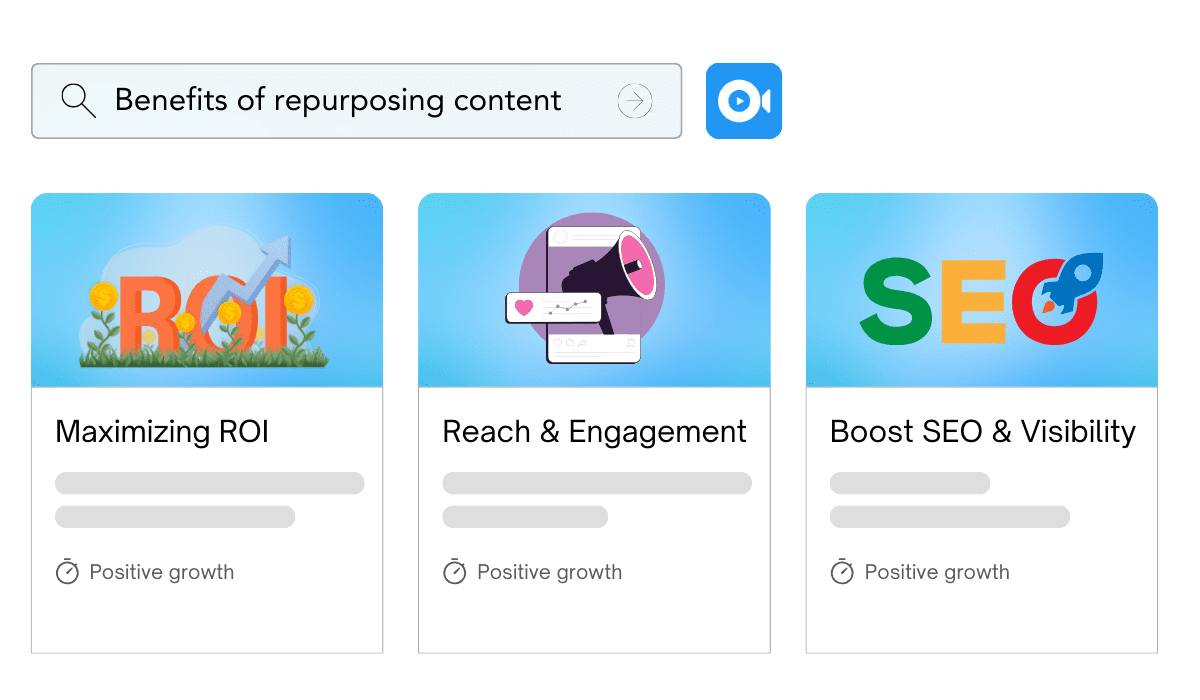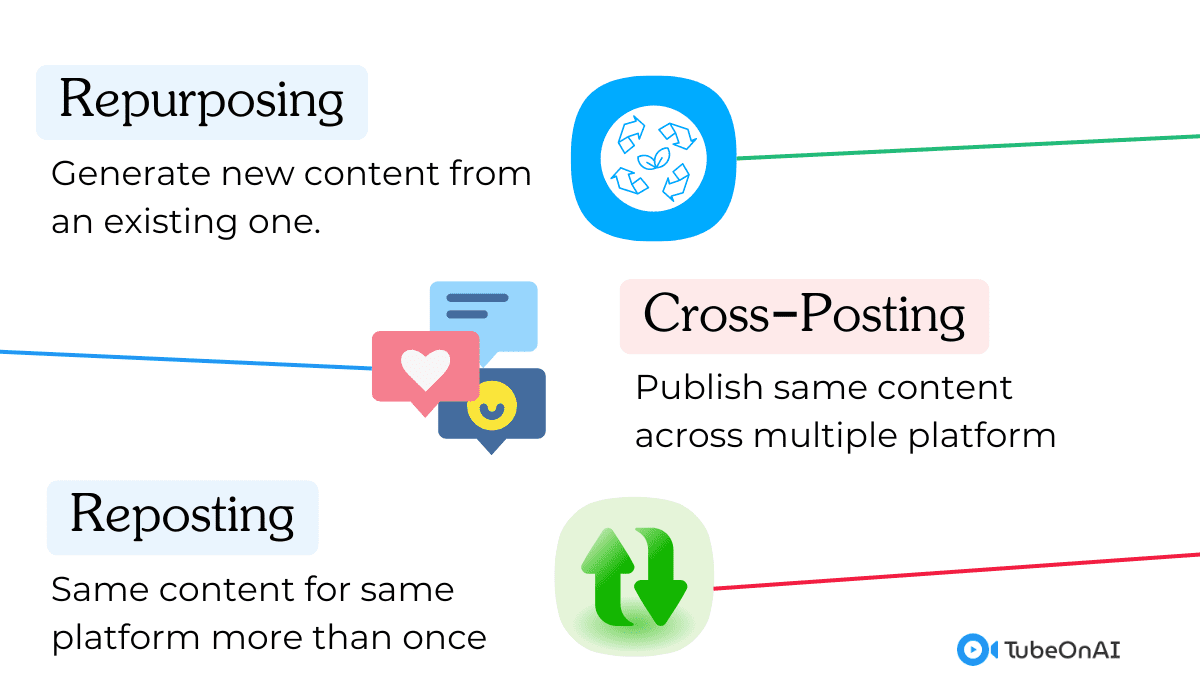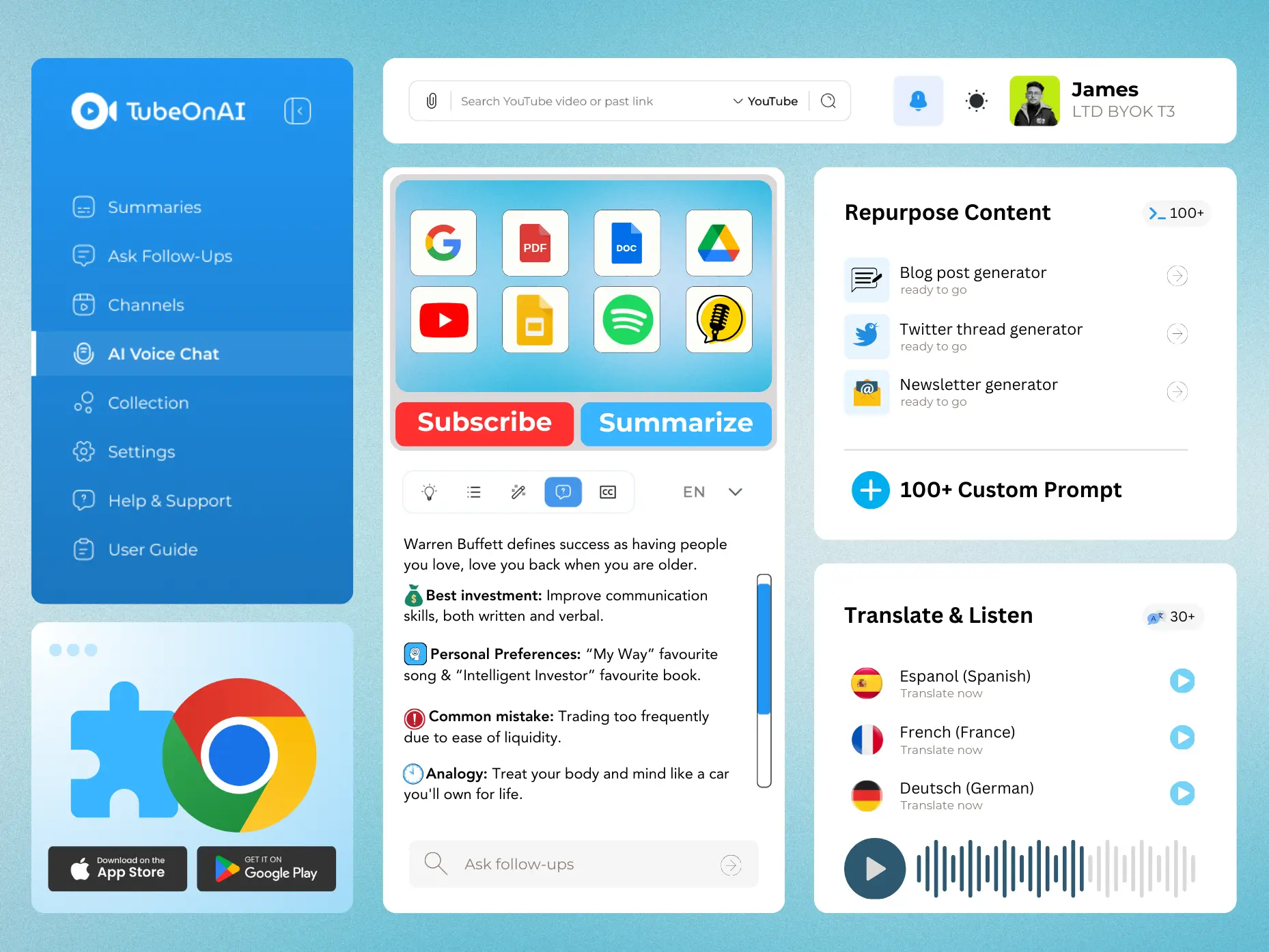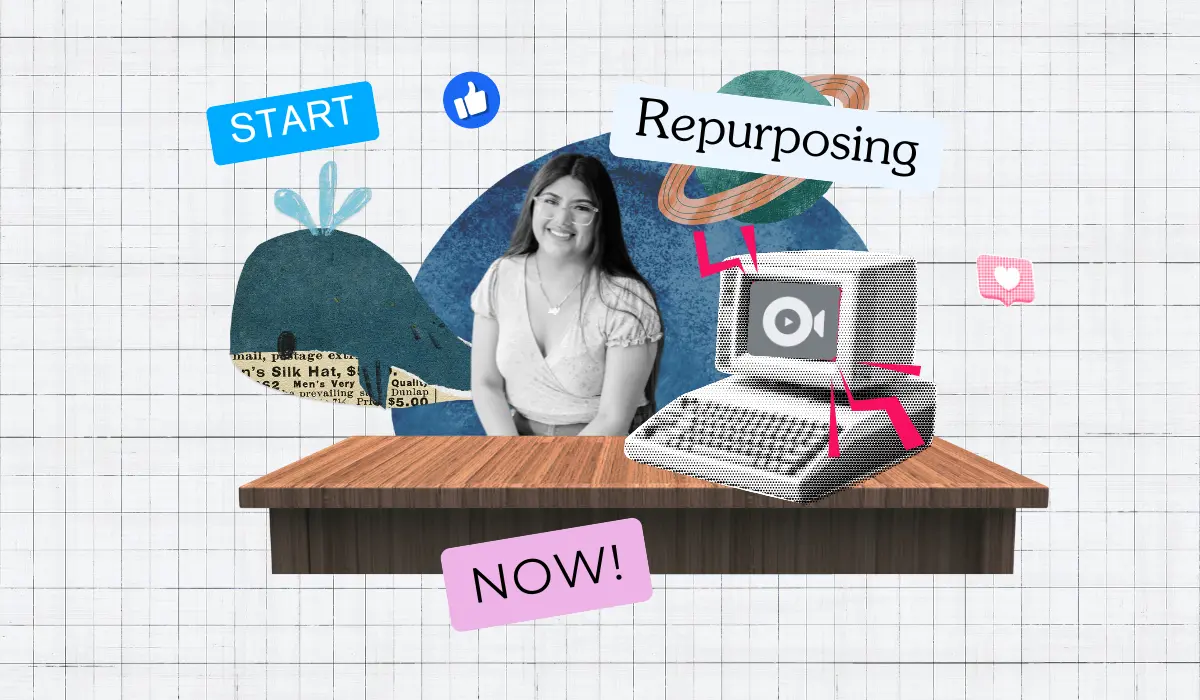Content repurposing is the process of transforming existing content into new formats to reach a wider audience. It involves adapting a blog post, video, podcast, or other form of content into something other than that form of content.
It’s about giving your existing content a new life. Instead of having it in one format, you can transform your creation into various content to reach a wider audience.
You can repurpose your content in only a few clicks, as AI tools like TubeOnAI speed up this process. To learn more about content repurposing strategy, follow us to the end to see how the magic happens.

Importance of repurposing content
Repurposing content is a no-brainer for reaching a wider audience without burning yourself out. Here are the benefits of repurposing content in today’s social media market:
1. Maximizing ROI (Return on Investment)
Great content costs you time, research, and effort. Repurposing helps you squeeze more value out of that investment. This approach multiplies your returns without multiplying your workload. It’s a sustainable way to grow without burning your team or budget. You’re not duplicating content, you’re reimagining it to reach more people in more places.
2. Expanding Reach and Engagement
Not everyone likes to consume content the same way. Some prefer deep-dive articles, while others look for quick reels, carousels, or audio clips they can absorb on the go. Through repurposing, you can meet your audience where they are, whether they prefer reading, watching, or listening.
By presenting content in various forms (written, visual, audio), you naturally increase your chances of being discovered and reached by more people. For example, you can easily turn a podcast into a blog post and reach a hearing-impaired audience.
3. Improve SEO and Search Visibility
Every new piece of content presents a new opportunity to be found online. Repurposing allows you to target different search terms, expand your topical relevance, and build internal linking, which is a great help for SEO.
For instance, repurposing a series of podcasts into a series of blog posts or short videos targeting related keywords can help dominate search engine results around that topic. Plus, the more content you publish, the more authority you build with search engines and your audience.
4. Keeping Consistency Across Channels
Consistency is key to building brand trust. Repurposing ensures that no matter where someone encounters your content, they get the same core message and values. Such alignment reinforces brand identity, improves recall, and creates a unified customer experience across touchpoints. When done right, it feels intentional and cohesive, not repetitive.
5. Saving Time and Resources
We understand creating high-quality content from scratch over and over again is exhausting. Repurposing is how you work smarter. Instead of constantly developing new ideas, you build on what already works.
This doesn’t mean being lazy. It means being strategic. You’re still delivering value with less stress, faster production, and more impact. For busy marketers, entrepreneurs, or creators, repurposing is the key to staying visible without burning out.

How is repurposing content different from cross-posting and reposting content?
Repurposing, cross-posting, and reposting may sound alike, but they each serve a distinct purpose in content marketing. Knowing the differences can help you get the most from your content and keep your audience engaged.
1. Repurposing Content
Repurposing content is giving your existing content a fresh spin. Let’s say you wrote an in-depth research article. You could turn that into an infographic for visual learners, break it down for social media posts, or even record a podcast episode. By doing this, you’re giving your audience multiple ways to digest your content.
2. Cross-Posting Content
Cross-posting is about spreading the same content across multiple platforms without changing a thing. Its purpose is to maximize exposure with minimal effort. If you’ve got something important to share, cross-posting can help get the word out fast.
3. Reposting Content
When you share the same content on the same platform more than once, it’s called reposting. This tactic is for keeping your evergreen content alive and ensuring your audience catches important updates they might have missed the first time around.
How do you prioritize which content you should repurpose?
When you’ve got a ton of content, where do you even start when it comes to repurposing? The trick is to focus on what’s already working.
Focus on your performance metrics and look at the articles, videos, or posts that your audience loves. If it resonated once, it’s a great candidate for repurposing.
From there, here’s how you can fine-tune what to prioritize:
1. Long-Term Relevance
Focus on creating evergreen content – those timeless pieces that don’t go out of style. These are gold because you can update them with just a bit of new info and keep them relevant for ages. It’s an easy win that keeps paying off.
2. Audience Preferences
What does your audience keep coming back for? If they love your blog posts, why not turn them into infographics or videos?
Repurposing popular content into the formats your audience prefers is a sure way to keep them engaged.
3. SEO Opportunities
If you have content that’s doing well in search, this is your chance to take it up a notch. Repurpose that content into different formats or update it with fresh info to improve its SEO. It’ll get you even more eyeballs on it.
4. Content Gaps in Your Strategy
Take a look at your overall content strategy – are there any gaps? Maybe there’s a topic you haven’t covered yet. You can repurpose that content to fill those gaps and keep things balanced.
5. Potential for Cross-Platform Distribution
Some content is just made to be shared across platforms. A solid blog post could become a podcast episode, or a long video could be clipped into bite-sized segments for social media. The more platforms you can repurpose for, the more people you’ll reach.

Best Strategies For Repurposing Content
Creating content takes time and effort, so why not make the most of it? Repurposing content for social media is one of the smartest ways to get more value from your hard work.
Here are some best strategies for how to repurpose content:
1. Transform Blog Posts into Social Media Content
If you have a great blog post packed with insights, utilize it. Break down the key points and turn them into attention-grabbing social media snippets.
Share quotes, interesting stats, or thought-provoking questions on platforms like Twitter, LinkedIn, or Instagram. Your audience will appreciate the fresh take, and you’ll stay top of mind.
2. Turn Webinars or Videos into Blog Posts
Take a recorded webinar or video tutorial, transcribe it, and transform the content into a well-structured blog post. While many prefer watching a video, some might appreciate reading a well-structured article on the same topic. Also, you get the bonus of better SEO.
3. Visualize Data with Infographics
If you’re sitting on a mountain of data or research, why not transform it into something visually engaging? Infographics present complex information in a digestible format. They’re also highly shareable, which means more eyes on your content.
4. Breathe New Life into Old Content
Content doesn’t have to be new to be useful. Look through your archives, find once-popular articles, and update them with fresh data. You’d be surprised at how well an updated piece can perform, especially when paired with good SEO practices.
5. Convert Articles into Email Newsletters
You might have tons of articles sitting on your website. Use the parts of them in your email newsletters to engage your subscribers. This is a great way to keep your audience informed and interested without needing to create brand-new content each time.
Can you use AI to repurpose content?
AI is your ultimate partner when it comes to repurposing content. It can help content creators, marketers, and business owners repurpose existing content for new platforms and audiences. AI makes the whole process faster and more efficient. Here’s how:
Summarizing and Condensing
AI tools can quickly create summaries that are perfect for social media. By pulling out the main points, it can turn your lengthy content into easily digestible pieces.
Converting Formats
AI doesn’t just stop at text. It can help you transform your written content into other formats like videos, podcasts, or presentations. You’ll be able to reach different audiences without having to reinvent the wheel.
Adapting for Different Audiences
If you want to reach a broader audience, AI has you covered. It can tweak the tone and style of your content. It even helps translate your content into different languages, so you can engage with audiences around the world.
5 ways to repurpose long-form video content
Got a long-form video that you’ve poured time and effort into? Don’t just let it sit there! Repurposing that content can help you reach more people by adapting it for different platforms and formats. Here are five effective ways to repurpose video content and make the most out of it:
1. Create Short Clips for Social Media
Long videos are gold mines for short, attention-grabbing clips. Take those key moments, insights, or highlights and turn them into clips for Instagram, TikTok, or Twitter. These short clips can help hook people and get them curious enough to check out the full video. Plus, they work perfectly as standalone posts that boost engagement.
2. Turn Videos into Blog Posts or Articles
You can easily convert your video into written content using AI. Once you’ve got the transcript, it’s just a matter of reworking it into a blog post, article, or even an ebook.
Even if your video doesn’t have the transcript, you can still do it through TubeOnAI.
3. Generate Podcast Episodes
Take the audio from your long-form video and repurpose it as a podcast episode. You’ll be giving your audience another way to consume your content.
4. Create Infographics or Visual Summaries
If your video dives into stats, data, or complex processes, break it down into a visual format. Infographics or visual summaries are not only super shareable, but they also make it easier for your audience to quickly digest the key points. You can use Canva or AI-powered design platforms to whip up eye-catching visuals that capture the main takeaways.
How Can I Make Repurposed Content More Engaging?
Repurposing content is a smart move, but making sure it stays engaging is the real trick. You’re taking something that’s already out there and giving it a fresh spin for new platforms or audiences. So, how do you keep it exciting? Here are a few strategies that can help:
1. Tailor for the Platform
Every platform has its own little world, right? What works on Twitter won’t necessarily fly on LinkedIn. So, tweak your content to fit the vibe of the platform. When your content feels right at home on a platform, people are more likely to engage with it.
2. Update with Fresh Insights
Even if you’re repurposing content, it shouldn’t feel stale. Add something new to the mix—whether it’s updated stats, recent trends, or new examples. It’ll keep your content relevant and show your audience you’re on top of things.
3. Utilize Visual Elements
Long blocks of text can be a snooze fest. Break things up with visuals. Not only does this make your content easier to digest, but visuals also help drive key points home.
4. Leverage Storytelling
Whether you’re turning an article into a video or a case study into a podcast, weaving in a good story makes your content way more engaging. People connect with stories on an emotional level, and that makes your message more memorable.
5. Personalize for Audience Segments
Not all your audience members are the same, so why should your repurposed content be? Customize it to speak directly to different groups. Maybe you can take a technical white paper and simplify it for beginners, or create a more in-depth version for experts.
8 Best Tools For Repurposing Your Content
As we said, having the right tools is essential. So, choose the one that actually matches your needs and ways to repurpose content. Here’s our list of 8 best repurposing tools to help you turn one piece of content into many:
- TubeOnAI – Repurpose any audio, video, or text-based content into different text-based formats
- Lumen5 – Easy video creation from text content
- Descript – AI Video Editor
- Canva – Versatile design platform for creating visuals
- InVideo – User-friendly video maker with AI
- ChatGPT – Generate different content formats from text
- AI Video Marketing Automator – Automate video creation and marketing workflows.
- Rev – Professional transcription and captioning services for videos
Check our dedicated blog on the best content repurposing tools for a detailed review of these tools.
Mistakes You Must Avoid While Repurposing Your Content
Here are key mistakes you must avoid when repurposing your content, along with how to do it right:
Repurposing content without considering how your audience prefers to consume information can lead to low impact, so always review analytics and cater to those preferences.
If you copy content into a new format without changing it, people might ignore it. To get better results, you should change the way it sounds, how it’s organized, and how long it is, so it fits well with the platform you’re using. This way, your content will hold people’s interest better.
When you share outdated information, it can harm how others see you and your trustworthiness. To prevent this, update any old content and check that it remains relevant and correct before you decide to use it again. Keeping information current and accurate helps maintain your good reputation.
It’s important to keep the main point easy to understand, no matter how you use it. Ensure it stays the same every time you share or present it so people always get the right idea.
Repeating the same content across all channels can make your brand feel stale, so try presenting the message differently or offering a new perspective each time.
You won’t know what’s working without measuring the performance of repurposed content, so constantly monitor results and adjust your strategy accordingly.
Reusing information that hasn’t worked or isn’t well-written is usually useless. It is better to focus your efforts on content that has proven profitable, has received great feedback, or has yet to be fully utilized.
Wrapping Up
So! As you learn what repurposing content is, you may boost your content to a broader audience. To help you in this journey, TubeOnAI can be your trusted partner for repurposing your content workflow. We have shared 7 best practices in this blog and have another dedicated post on 30 creative ways to repurpose content. You can check that, too, for more repurposing ideas. You can also get more help from this app regarding content marketing endeavors.


